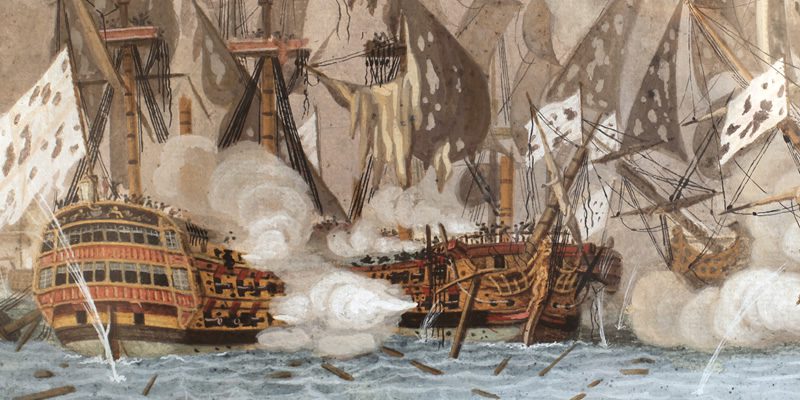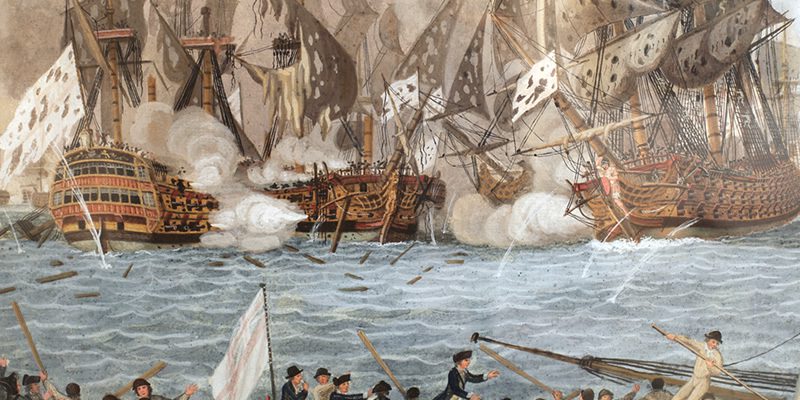Naval Combat Rules for D&D 5th Edition – Part 2
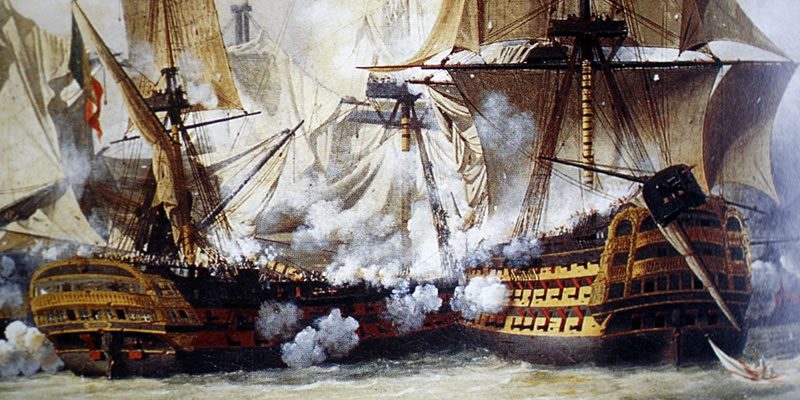
Part 1 | Part 2 | Part 3 | Part 4 | Sea Chases & Complications
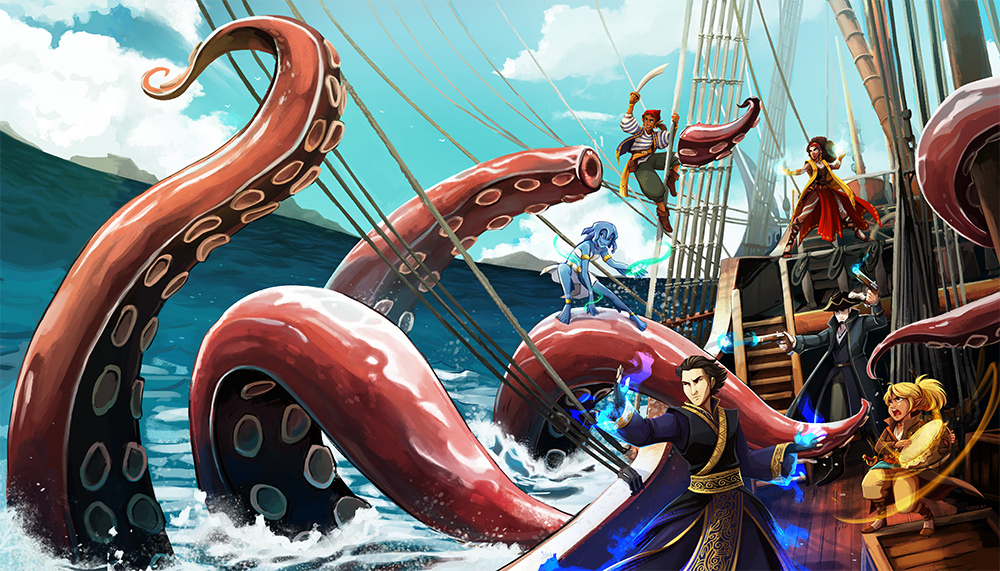
The Seas of Vodari – 5th Edition Swashbuckling & Sorcery
Everything you need to run exciting seafaring campaigns full of swashbuckling action and magical adventure for Fifth Edition.
The Seas of Vodari is a full-color book that we are offering in hardcover and PDF. This book provides 200+ pages of material for gamemasters to run exciting seafaring campaigns for 5th Edition. Your players will get tons of options for creating characters and you’ll get support to run a world full of swashbuckling action and magical adventure.
Get the Seas of Vodari at DriveThruRPG › Pre-Order the Hardcover ›
For my homebrew seafaring campaign setting (called Vodari), I needed to create a way to run naval battles for the 5th edition rules of D&D. I wanted something that fit into the elegant simplicity of 5th edition, versus adding a bunch of complicated math to run sea battles. Part 1 of this series covered basic naval combat. This article continues the series and digs deeper, providing more naval combat rules ideas and examples. Pick and choose what works and add your own rules. Create the type of naval combat your want to run, whether its a tactical grid battle or more of a narrative challenge where your PCs determine the outcome of the battle.
Setting Up a Naval Battle
Before a sea battle can start the following must be considered. This was covered in Part 1, but I have included it here again with more details.
- Weather & Visibility. Will the weather be a factor with wind speed and direction, storms or waves?
- See page 109 of the DMG to roll random weather
- High winds can provide a boost to pilots who can catch it in their sail and a penalty for pilots who try to battle against it.
- Rolling seas, storms and high winds will increase the difficulty rating (CR) for pilot checks
- A calm sea and clear sky offers great visibility from the crow’s nest with the ability to spot another ship up to 10 miles away, overcast 5 miles, raining 1 mile and fog 100 to 300 feet.
- Speed. How fast is each ship moving? Can it speed up on its own? For example, double time when using oars or letting out more sail.
- Position of the Ships (Facing). This is just like positioning tokens for monsters and PCs, only now the tokens are rectangles and facing does matter.
- It might be a good idea to sketch out the positions for you players, if you are not using grid combat.
- You might wait to do this until the ships are close to each other. If you have a big enough table or screen, place them at long range.
- Range.
- How far away can either ship start to fire at the other ship with weapons or magic?
- It is important that you and your players know the distance between the two vessels.
- It is up to you to decide how many weapons could actually be aimed at a boat, if it is in range due to the facing of each vessel.
- A look at attack ranges:
- More than 2,400′: Outside of attack range.
- 2,400′ – 1,200′: Far range of full size cannons (disadvantage)
- 1,200′ – 600′: Medium range of full size cannons (disadvantage) and far range of some siege weapons.
- 600′ – 250′: Cannons will fire with accuracy and swivel cannons fire with disadvantage. Most siege weapons start to be in range. Some range weapon such as long bows will start to be in long range.
- 250′ and closer: Cannons, swivel cannons, siege weapons, range magic and range weapons are all in range and combine to make any encounter at this distance deadly in a very short period of time.
- Initiative. If either ship is in attack range and both ships are aware of each other, roll initiative.
- Ships have no initiative bonus.
- As an optional rule, you can add the Captain or pilot’s initiative bonus to the roll.
- If one ship clearly should go first due to an advantage, skip the roll and place that ship first in the order.
- Ship. What are the basic stats for each ship in the battle?
- How many crew are on the ship?
- How many HP does the ship have? Do you want sails and oars to have their own HP?
- What attacks and damage can a ship fire each round? What is the range of each attack type? How much damage can the ship make by ramming another ship?
- What is the speed and propulsion type for the ship? Does it use sails and/or oars?
- What amount of damage can a ship take to its sails/rigging or oars before it is drifting?
- What amount of damage can a ship take to its hull before it is holed?
Officer Actions
It would be pretty boring to have your players sitting around during the combat while one person does all the work. This was covered in Part 1, but I have included it here again with more details.
On the ship’s initiative all players can use their turn to complete an officer action.
Let’s have the PCs be part of a pirate crew and let’s give them all a job. Assign them jobs such as:
- Captain/First Mate
- Rally. Allow player to intimidate/inspire the crew once per battle for an advantage on a roll. Make a Charisma check with a DC of 10 (or higher if crew is disloyal or in real trouble).
- Weak Spot. Allow player to look for a weakness in the defenses of the enemy’s vessel. Make an Intelligence check with a DC of 15 (adjust for conditions) to spot a weakness and give advantage on the next attack roll that targets that weakness
- Pilot
- Have the pilot make a Dexterity check to make sure they are controlling the ship well, failure can result in the ship slowing, not turning, etc.
- The helm must be controlled by a player or NPC or the ship will be drifting.
- For pilot checks you can add the pilot’s DEX modifier and proficiency to the roll, if they are a skilled pilot. You could make sailing proficiency part of a feat, added to Sailor background or something that you add to the PCs background.
- As an optional rule you can add the pilot’s DEX modifier to the AC of the ship if they are a skilled pilot.
- Cannoneers
- at long range, have your players aim the big guns. Two to three crew are required to operate a full size cannon.
- at close range:
- Have your players without ranged attacks man the swivel cannons and let them roll the attacks and damage. Only one to two crew are required to operate a light cannon.
- Have an officer be the master gunner and allow them to add their Dexterity and Proficiency to all attacks or take the +6 from the DMG, whichever is higher.
- If no officer is in charge of the guns, then a cannon’s attack bonus should be only +2
- Spellcasters – have them make their own attacks, put out fires, mend the ship, etc.
- Surgeons – A ship’s surgeon must have some kind of clerical/healing skill. The surgeon can restore 1 crew member per turn, DC 10 with any related modifiers added on.
Damage and Repair
This was covered in Part 1, but I have included it here again and I have added a light cannon to the mix.
- Let’s go with cannons (see page 255 of DMG) firing iron balls for this example:
- Light Cannon (Swivel): 1d20+6, range 250 feet/500 feet, hit 18 (4d8) bludgeoning damage. It takes one action to load the cannon, one action to aim & fire it. Can be manned by one or two crew and it can be turned to attack nearly any target, but it is recommended not to fire across your own boat. Swivel cannons are positioned on the top deck and can be used to attack from bow and stern. They can also be used to attack crew and sails.
- Cannon: 1d20+6, range 600 feet/2,400 feet, hit 44 (8d10) bludgeoning damage. It takes one action to load the cannon, one action to aim it and one action to fire it. Can be manned by one to three crew.
- If an attack hits with fire damage and it is a critical hit, the vessel should be on fire.
- Feel free to adjust the damage output of cannons down if you want to increase the importance of ranged weapons and ranged spellcasting.
- Repairs to the ship can be made when the vessel is berthed (see page 119 in DMG) or if a player uses powerful magic spells such as fabricate (the mending cantip can not fix a boat). Don’t be afraid to let a player get creative with a spell slot.
Advanced Combat Example
Let’s revise the example from Part 1 and try adding in some pilot checks. For this example the scenario is a pirate vessel is chasing a merchant ship towards a storm. The merchant has very bad luck on its rolls to speed through combat.
Assumptions:
- Weather & Visibility: Light rain, heavy wind blowing northwest and rolling seas. A large storm is on the horizon to the west. Let’s start with piloting in these condition at DC 10.
- Location & Range: 2 ships are 600 feet from each other and both are traveling west. You can plot this exactly on a grid or you can run theatre of the mind by just determining approximately how far apart the two ships are after each move.
- Speed: Both ships are traveling 30′ per round. For simplicity, I allow ships to move by full or half squares.
- Initiative: Ship A has initiative and is chasing Ship B into the storm.
- Ships: Both ships are identical Caravels (See Sailing Ship on page 118 of 5e DMG) with 20 crew.
- Cannons: For simplicity, cannons each have a full crew and reload each round and are ready to fire.
| Round | Ship A (Pirate) | Ship B (Merchant) |
|---|---|---|
| 1 | Movement:
Attacks: Out of range / no shot for fixed cannons |
Movement:
Attacks: Out of range / no shot for fixed cannons |
| 2 | Movement:
Actions: Bow Cannon: Out of range Port Cannons (4):
|
Status:
Movement:
Actions: Out of range / no shot for fixed cannons |
| 3 | Movement:
Actions: Bow Cannon: Out of range
|
Status:
Movement:
Actions: Surgeon:
Stern Cannon:
|
| 4 | Status:
Movement:
Actions: Weak Spot: Roll 4 (1d20) + 4 = 8 (Fail) Bow Cannon:
Port Cannons (4):
|
Status:
What’s Next?
|
What’s Next
- In part 3 I’ll be examining more officer actions, boarding and more. Let me know in the comments below if there are any specific rules/scenarios you’d like to see covered.
- Continue to Part 3
Check Out Our Naval Combat Guide
Batten Down the Hatches!
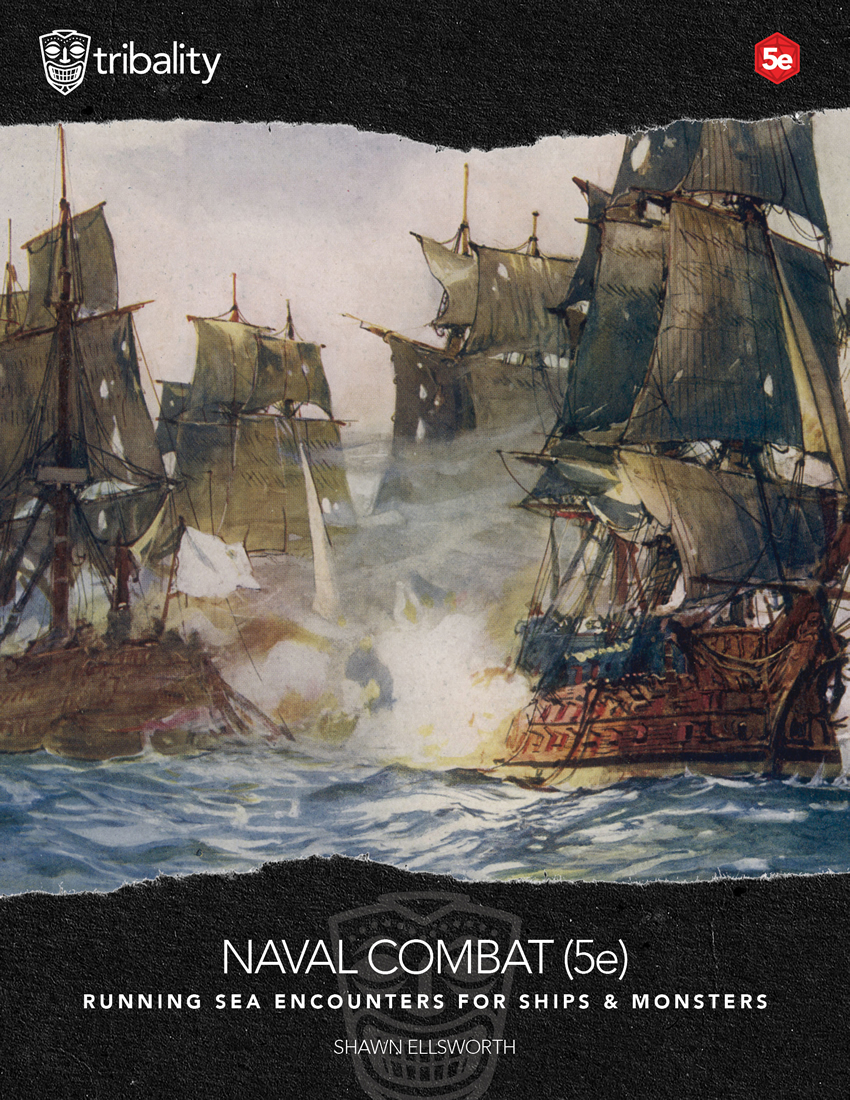 Are you looking to run exciting, fast paced naval encounters where all your players have something to do each turn? Do you want to run cinematic sea battles between ships and terrify your players with sea monster attacks?
Are you looking to run exciting, fast paced naval encounters where all your players have something to do each turn? Do you want to run cinematic sea battles between ships and terrify your players with sea monster attacks?
I wrote this guide after running a weekly seafaring campaign for Fifth Edition for over a year. NAVAL ENCOUNTERS provides GMs with rules, ideas and examples for running combat and other scenarios at sea for your Fifth Edition game. Whether you are looking for rules to run an encounter between ships, naval combat roles to give to each of your players, or ideas on how to handle a sea monster attack, this guide is the answer.
Product Information
This guide provides GMs with rules and ideas to run exciting, fast paced naval combat encounters. In this guide you will find:
- Rules for running lightweight naval encounters
- Example combat encounters
- Shipboard roles for your Captain, Master Gunner, Ship’s Surgeon and other officers
- Stats for guns, cannons and ships
These materials were designed to be used with Fifth Edition rules.

